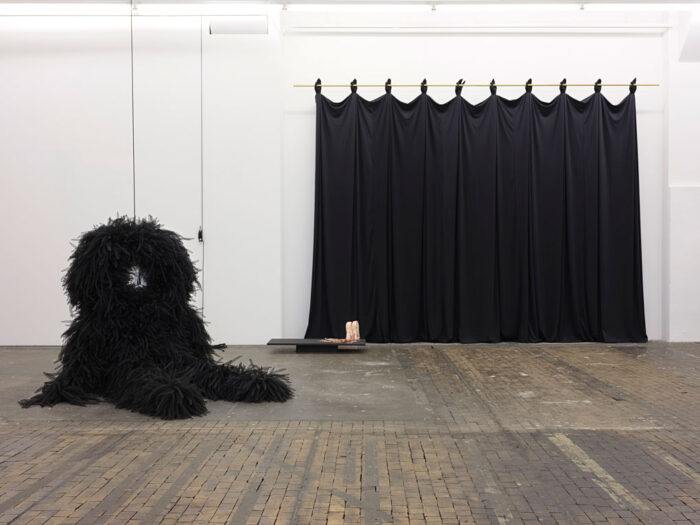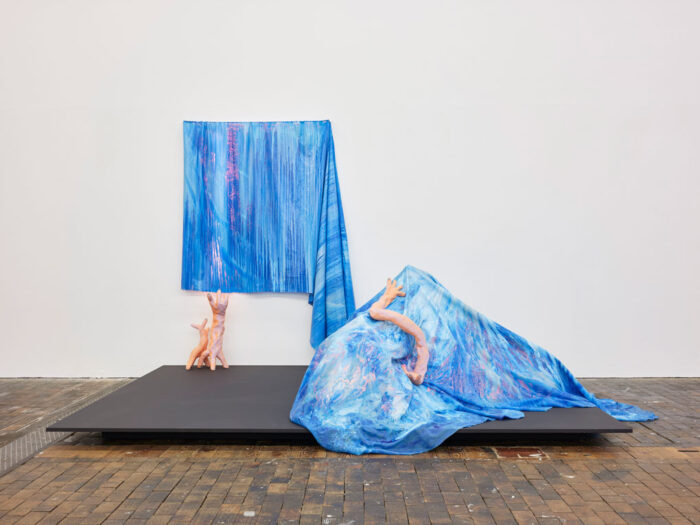Stitches
An investigation into the use of textiles in contemporary art practices
As the first chapter of a long-term research project, the collective exhibition STITCHES: Scènes, corps, décors [stages, bodies, sets] opened at Le Commun, Bâtiment d’art contemporain, in Geneva last month (17 June to 11 July 2021). The exhibition showcased a selection of 35 emerging and established artists and collectives, who were invited to create ties around the notions of body, stage, decors, and representations of the self. Looking at the “knot” as the elementary pattern of fabric and the “stitch” as the technique of puncturing the flesh or textile to assemble and unite, the project opened a sphere for debate on the use of this malleable material in today’s contemporary art landscape.
Artists featured are James Bantone, Pierrette Bloch, Mario Botta, Pauline Boudry/Renate Lorenz, Lisa Biedlingmaier, Gregory Bourrilly, Sarah Burger, Denise Emery, Sylvie Fleury, Gina Folly, Cee Füllemann, Vidya Gastaldon, Nicola Genovese, Maëlle Gross, Roman Gysin, Katharina Hohmann, Inner Light, Sophie Jung, Marjorie Kapelusz, Thomas Liu Le Lann, Deirdre O’Leary, Céline Manz, Léa Katharina Meier, Julie Monot, Sandrine Pelletier, Mai-Thu Perret, Andrea Cindy Raemy, Sabrina Röthlisberger, Ugo Rondinone, Denis Savary, Roman Signer, Marco Simao, Mina Squalli-Houssaïni, Tobias Spichtig, Manon Wertenbroek. An exhibition project developed and curated by Gabrielle Boder, Tadeo Kohan and Camille Regli, on behalf of Collectif Détente.
The research starts with the following question: if the integration of textile into the history of 20th century art constituted a significant factor in the reversal of the so-called “dominant categories”—starting, among others, in the 1910s with the upheaval of artistic and aesthetic hierarchies followed by the 60-70s’ technical hijack, feminist emancipation and civil rights movements, and more recently Western and patriarchal decentering—what is the situation today?


Stemming from the knot as a symbol of connectivity and interlace (entrelacs in French), but also the primary elements constituting fabric, the exhibition project investigates the use of this ductile material in recent decades. Questioning the appeal of textile in contemporary practices and its subversive power, the aim is to explore the intimate relationships that the material holds with the body and its spaces of representation—shedding light on the ambivalent relationship that subsists between art and textiles, in particular its extraction from the private, the decorative or the fashion fields to the political and protests, as well as integrating galleries and institutional spaces.


With a focus on the Swiss art scene, the first chapter of this research, titled STITCHES: Scènes, corps, décors, offers a reflection on the contemporary context of production, dipping into the charged history of the material. Combining emblematic works by historical artists (such as Pierrette Bloch, Denise Emery or architect Mario Botta) with established artists (from Sylvie Fleury, Vidya Gastaldon, Mai Thu Perret to Ugo Rondinone) and contemporary works and new productions by artists from different generations and linguistic regions of Switzerland, the exhibition weaves links and references from the 1990s artistic scene until today. Shown in Geneva, STITCHES: Scènes, corps, décors navigates through the prism of intertwined and complementary axes, which are expressed in three subsections:


One, the domestic
Coupled with the decorative and furniture setting, textile is naturally ascribed to the domestic, to the everyday use and to the home—perceived as a space of comfort, shelter or confinement. Composed of “object-works” (beds, carpets, tables, decorations, windows), the collective and disparate furnishings of the space disturb the principle of intimacy inherent to the domestic sphere, and question shared environments and identities. Occupying the walls, floor and ceiling, the works interact and shape the architecture, revisiting their functions as objects. The works also subtly allude to a set of historical references tied to the breakdown of notions such as craft, design and the decorative.

Second, the performative set
When the home becomes the stage, garments become costumes, objects the props, and decors a set. Curtains open and the space for public representation awakens, bringing with it fiction and storytelling. By embodying and diverting stage codes, the works explore the staging of the self and its relationship to theatricality and performativity. A tension arises from the lack of activation from dormant props to passive bodies. An orchestrated dichotomy between appearance and disappearance culminates, blurring the lines between scenic space and white cube. The sets are open and laid bare. There is no backstage, no beginning nor end. Textiles hence appear as a revealing element, triggering reflections on mobility, fluidity, and metamorphosis—the starting points for movements and transformations.

Third, bodies, skins, personae
The exhibition is also built around a multiplicity of tri and bidimensional bodies or “personae”—a Latin term used to define ancient theatre’s masks, often associated with archetypes and their roles in society. Therefore, sculptural bodies and visitors meet in a collective narrative, mingling between presence and absence, mythical and familiar figures, portraits and self-portraits. A crowd of anthropomorphic, mutant, abstract, flawed and glitched beings unfolds, summoning up a frontal relationship to visitors. They face each other, looking and being looked at, forming an uncanny social space in which to wander. Fabric composes and masks. It becomes a catalyst for affirmation, for assembling and separating.

By contrast and affinity, the works in STITCHES: Scènes, corps, décors create a joint community—an interlace that nourishes a formal, tactile, and narrative dialogue between abstraction and figuration, ready-made and know-how, stages, bodies, and decors. The artists meet in a nodal setting linking intimacy and extimacy, constraint and liberation, emancipation and domestication. From suture stitch to sewing stitch, carnal and woven materials respond to each other, interweaving through the private, scenic, and social spheres.



